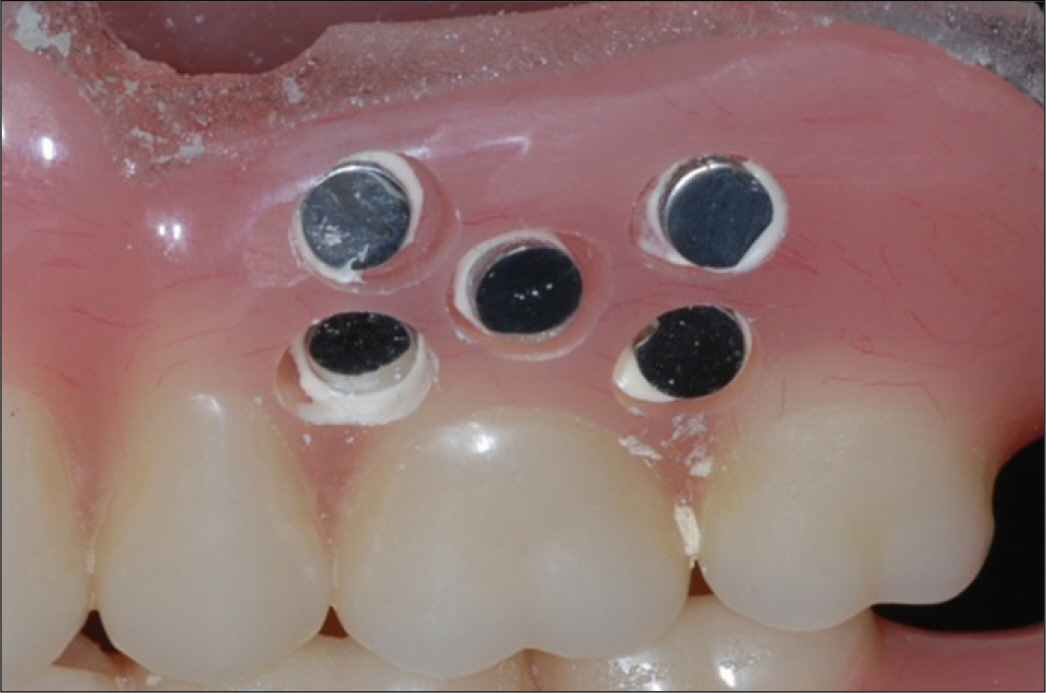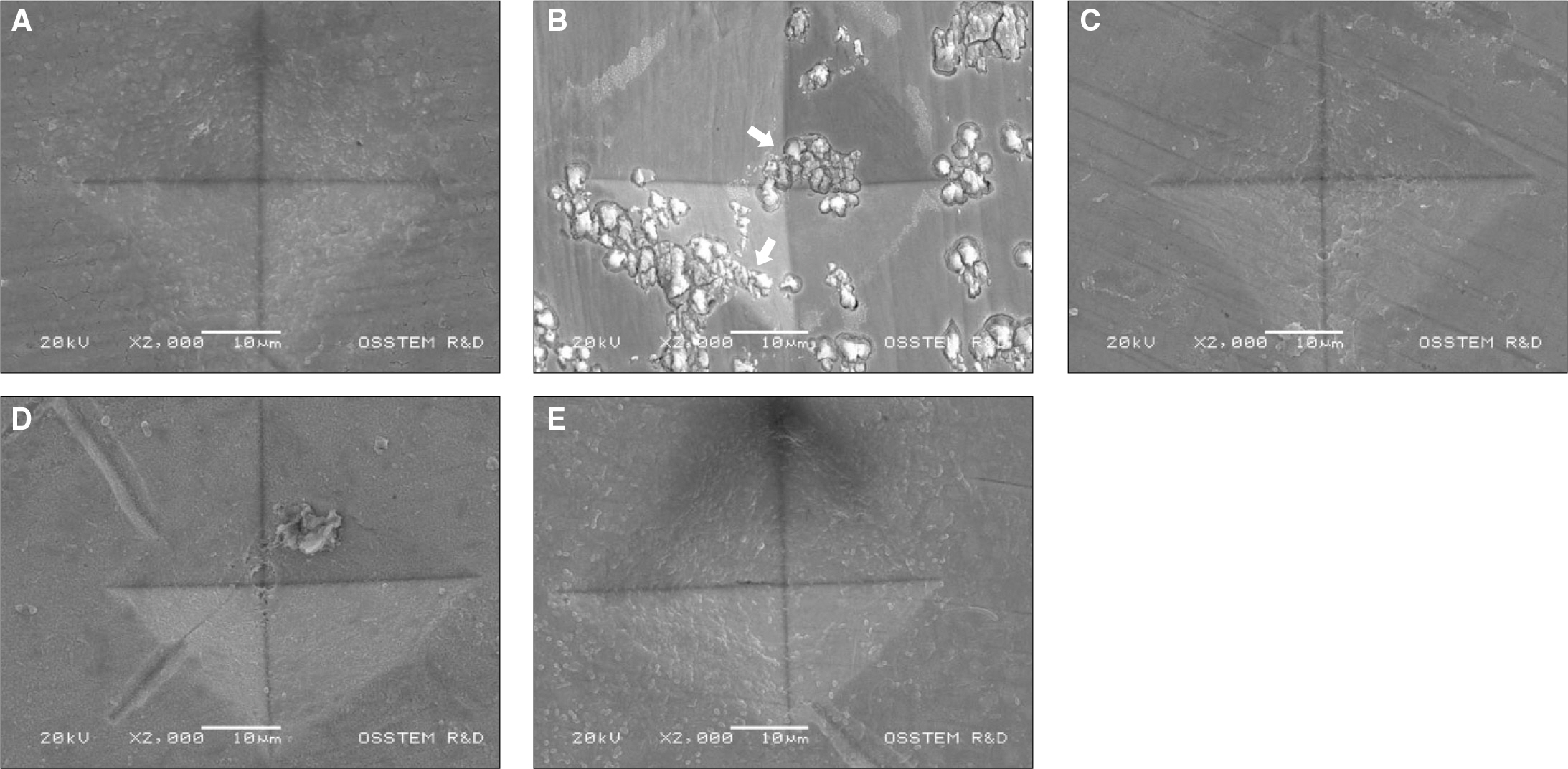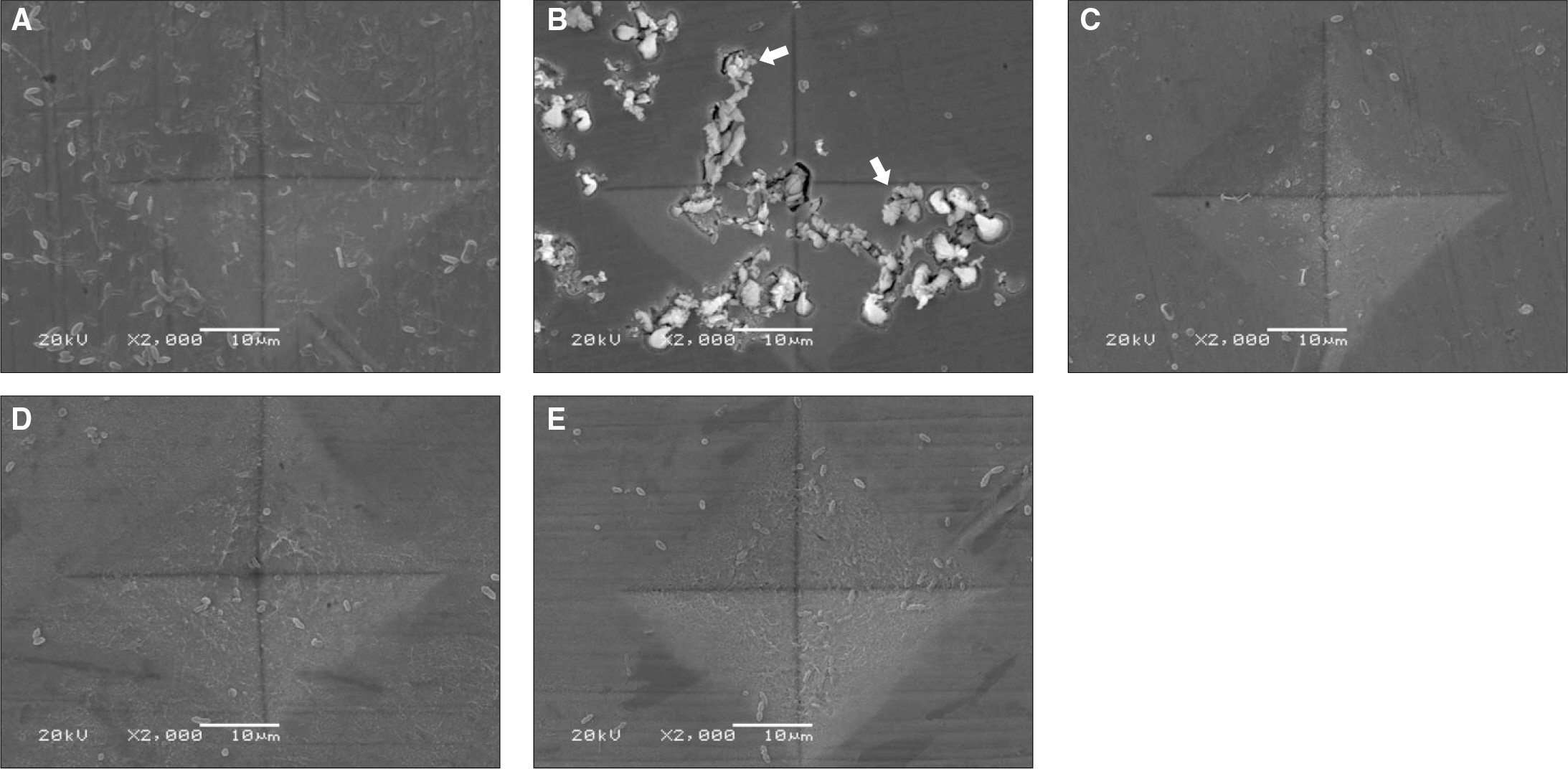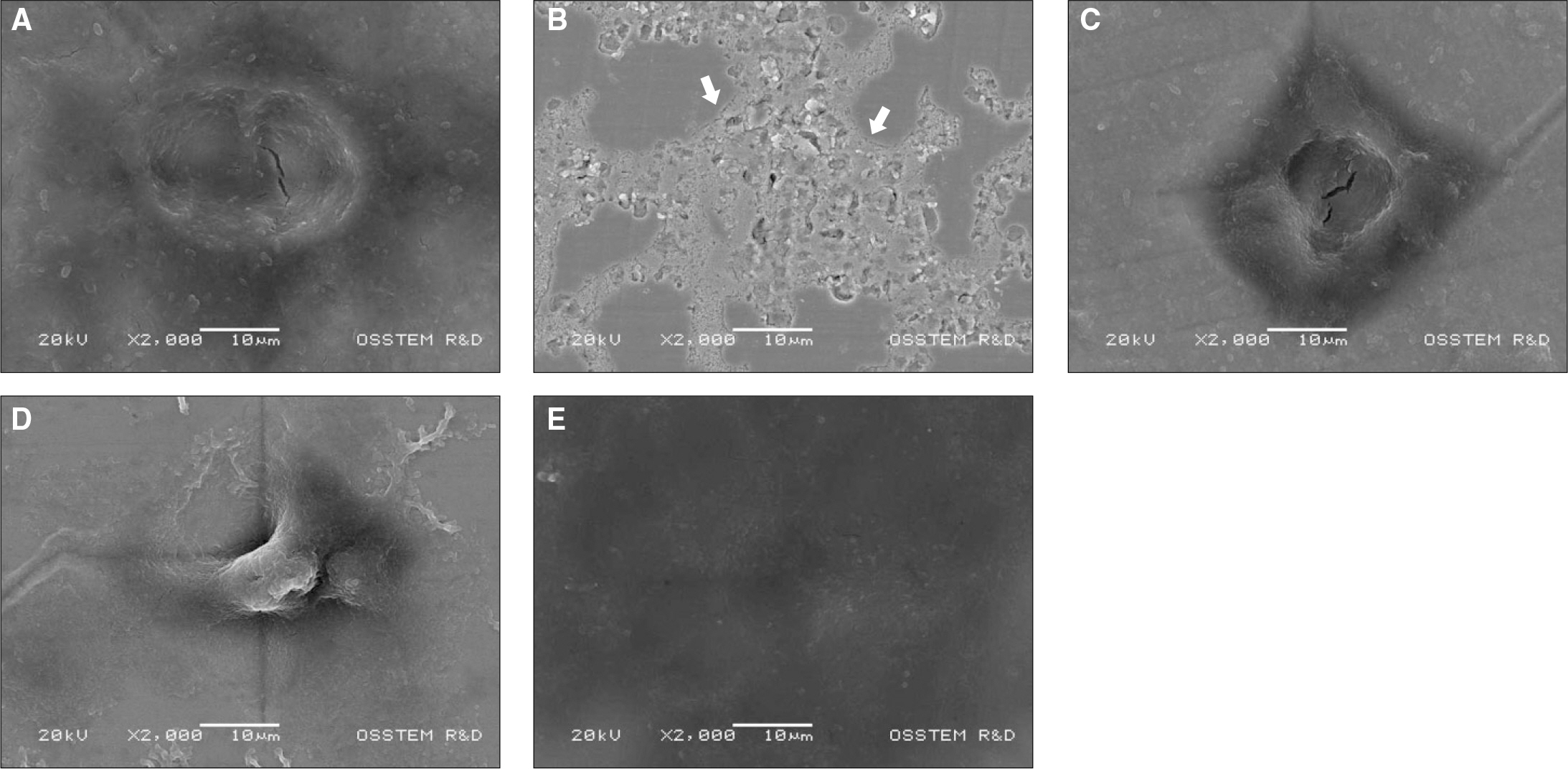J Korean Acad Prosthodont.
2011 Jan;49(1):57-64. 10.4047/jkap.2011.49.1.57.
The efficacy of denture cleansing agents: A scanning electron microscopic study
- Affiliations
-
- 1Department of Prosthodontics, School of Dentistry, Pusan National University, Yangsan, Korea. cmjeong@puasn.ac.kr
- KMID: 2000284
- DOI: http://doi.org/10.4047/jkap.2011.49.1.57
Abstract
- PURPOSE
The purpose of this study was to compare the cleansing performance of a distilled water, a diluted solution of sodium hypochlorite as a household bleaching cleanser and three alkaline peroxide cleansers in vivo plaque deposits by using scanning electron microscope.
MATERIALS AND METHODS
Five individuals were selected from department of the prosthodontics in Pusan National University Hospital, and each of them was inserted with specimens for plaque accumulation in their temporary dentures for 48 hours. The specimens were removed and cleaned by each cleansing agents for 8 hours. Scanning electron micrographs were made from the specimens at a magnification of x2,000. A panel of ten persons with a dental or paradental background, but not directly involved in the study, was selected to analyze the photomicrographs to determine which denture cleanser was more effective in removing plaque.
RESULTS
Diluted solution of sodium hypochlorite was the most effective at removing plaque following Polident(R), Cleadent(R)e, Bonyplus(R) and distilled water in order. But there was no significant difference of cleansing efficacy between diluted solution of sodium hypochlorite and Polident(R), Polident(R) and Cleadent(R)e, Cleadent(R)e and Bonyplus(R), respectively (P > .05). Alkaline peroxide cleansers by themselves cannot adequately remove accumulated plaque deposits, especially if the deposits are heavy. Corrosion could be seen on the surface of non-precious alloy specimens immersed in diluted solution of sodium hypochlorite.
CONCLUSION
It is recommended to use of alkaline peroxide type cleansers with brushing whenever possible, since denture cleanliness is often poor due to the relative inefficiency of these cleansers.
Keyword
MeSH Terms
Figure
Reference
-
1.Douglass CW., Gammon MD., Atwood DA. Need and effective demand for prosthodontic treatment. J Prosthet Dent. 1988. 59:94–104.
Article2.Gordon SR. Older adults: demographics and need for quality care. J Prosthet Dent. 1989. 61:737–41.
Article3.Shay K. Denture hygiene: a review and update. J Contemp Dent Pract. 2000. 1:28–41.
Article4.Jagger DC., Harrison A. Denture cleansing-the best approach. Br Dent J. 1995. 178:413–7.
Article5.Budtz-Jorgensen E., Bertram U. Denture stomatitis. I. The etiology in relation to trauma and infection. Acta Odontol Scand. 1970. 28:71–92.6.Neill DJ. A study of materials and methods employed in cleaning dentures. Br Dent J. 1968. 124:107–15.7.Nikawa H., Hamada T., Yamamoto T. Denture plaque-past and recent concerns. J Dent. 1998. 26:299–304.8.Budtz-Jo ¨rgensen E. The significance of Candida albicans in denture stomatitis. Scand J Dent Res. 1974. 82:151–90.9.Budtz-J � rgensen E. Materials and methods for cleaning dentures. J Prosthet Dent. 1979. 42:619–23.10.Augsburger RH., Elahi JM. Evaluation of seven proprietary denture cleansers. J Prosthet Dent. 1982. 47:356–9.
Article11.Keng SB., Lim M. Denture plaque distribution and the effectiveness of a perborate-containing denture cleanser. Quintessence Int. 1996. 27:341–5.12.Ghalichebaf M., Graser GN., Zander HA. The efficacy of denture-cleansing agents. J Prosthet Dent. 1982. 48:515–20.
Article13.Abelson DC. Denture plaque and denture cleansers. J Prosthet Dent. 1981. 45:376–9.
Article14.Rudd RW., Senia ES., McCleskey FK., Adams ED Jr. Sterilization of complete dentures with sodium hypochlorite. J Prosthet Dent. 1984. 51:318–21.
Article15.Robinson JG., McCabe JF., Storer R. Denture bases: the effects of various treatments on clarity, strength and structure. J Dent. 1987. 15:159–65.
Article16.Backenstose WM., Wells JG. Side effects of immersion-type cleansers on the metal components of dentures. J Prosthet Dent. 1977. 37:615–21.
Article17.Mueller HJ., Greener EH. Characterization of some denture cleansers. J Prosthet Dent. 1980. 43:491–6.
Article18.Nikawa H., Hamada T., Yamashiro H., Kumagai H. A review of in vitro and in vivo methods to evaluate the efficacy of denture cleansers. Int J Prosthodont. 1999. 12:153–9.19.Connor JN., Schoenfeld CM., Taylor RL. Study of in vivo plaque formation. J Dent Res. 1976. 55:481–8.
Article20.Connor JN., Schoenfeld CM., Taylor RL. An evaluation of an enzyme denture cleanser. J Prosthet Dent. 1977. 37:147–57.
Article21.Palenik CJ., Miller CH. In vitro testing of three denture-cleaning systems. J Prosthet Dent. 1984. 51:751–4.
Article22.Gwinnett AJ., Caputo L. The effectiveness of ultrasonic denture cleaning: a scanning electron microscope study. J Prosthet Dent. 1983. 50:20–5.
Article23.Catalan A., Herrera R., Martinez A. Denture plaque and palatal mucosa in denture stomatitis: scanning electron microscopic and microbiologic study. J Prosthet Dent. 1987. 57:581–6.
Article24.Altman MD., Yost KG., Pitts G. A spectrofluorometric protein assay of plaque on dentures and of denture cleaning efficacy. J Prosthet Dent. 1979. 42:502–6.
Article25.Mandel ID. Relation of saliva and plaque to caries. J Dent Res. 1974. 53:246–66.
Article26.Hutchins DW., Parker WA. A clinical evaluation of the ability of denture cleaning solutions to remove dental plaque from prosthetic devices. N Y State Dent J. 1973. 39:363–7.27.Basson NJ., Quick AN., Thomas CJ. Household products as sanitising agents in denture cleansing. J Dent Assoc S Afr. 1992. 47:437–9.28.Barnabe ′W., de Mendonça Neto T., Pimenta FC., Pegoraro LF., Scolaro JM. Efficacy of sodium hypochlorite and coconut soap used as disinfecting agents in the reduction of denture stomatitis, Streptococcus mutans and Candida albicans. J Oral Rehabil. 2004. 31:453–9.
Article29.Lima EM., Moura JS., Del Bel Cury AA., Garcia RC., Cury JA. Effect of enzymatic and NaOCl treatments on acrylic roughness and on biofilm accumulation. J Oral Rehabil. 2006. 33:356–62.
Article30.Jagger DC., Al-Akhazam L., Harrison A., Rees JS. The effectiveness of seven denture cleansers on tea stain removal from PMMA acrylic resin. Int J Prosthodont. 2002. 15:549–52.31.Trevelyan MR. The prosthetic treatment of hepatitis B antigen positive patients. Br Dent J. 1974. 137:63–4.
Article32.Kastner C., Svare CW., Scandrett FR., Kerber PE., Taylor TD., Semler HE. Effects of chemical denture cleaners on the flexibility of cast clasps. J Prosthet Dent. 1983. 50:473–9.
Article33.Anthony DH., Gibbons P. The nature and behavior of denture cleansers. J Prosthet Dent. 1958. 8:796–810.
Article34.McCabe JF., Murray ID., Kelly PJ. The efficacy of denture cleansers. Eur J Prosthodont Restor Dent. 1995. 3:203–7.35.Tarbet WJ., Axelrod S., Minkoff S., Fratarcangelo PA. Denture cleansing: a comparison of two methods. J Prosthet Dent. 1984. 51:322–5.
Article36.Moore TC., Smith DE., Kenny GE. Sanitization of dentures by several denture hygiene methods. J Prosthet Dent. 1984. 52:158–63.
Article37.Nakamoto K., Tamamoto M., Hamada T. Evaluation of denture cleansers with and without enzymes against Candida albicans. J Prosthet Dent. 1991. 66:792–5.
Article38.Minagi S., Tsunoda T., Yoshida K., Tsuru H. Objective testing of the efficiency of denture-cleansing agents. J Prosthet Dent. 1987. 58:595–8.
Article39.Keenan MP., Shillingburg HT Jr., Duncanson MG Jr., Wade CK. Effects of cast gold surface finishing on plaque retention. J Prosthet Dent. 1980. 43:168–73.
Article40.Clayton JA., Green E. Roughness of pontic materials and dental plaque. J Prosthet Dent. 1970. 23:407–11.
Article
- Full Text Links
- Actions
-
Cited
- CITED
-
- Close
- Share
- Similar articles
-
- Denture Cleansers
- Isolation and Identification of Melanosomes from Human Hair
- Effects and clinical considerations of denture adhesives
- Morpholgical Study of Korean Pubic Louse , Phthirus pubis ( Linnaeus , 1758 ) by Light and Scanning Electron Microscopy
- Scanning electron microscopic study of capillary change in bleomycin-induced pulmonary fibrosis





